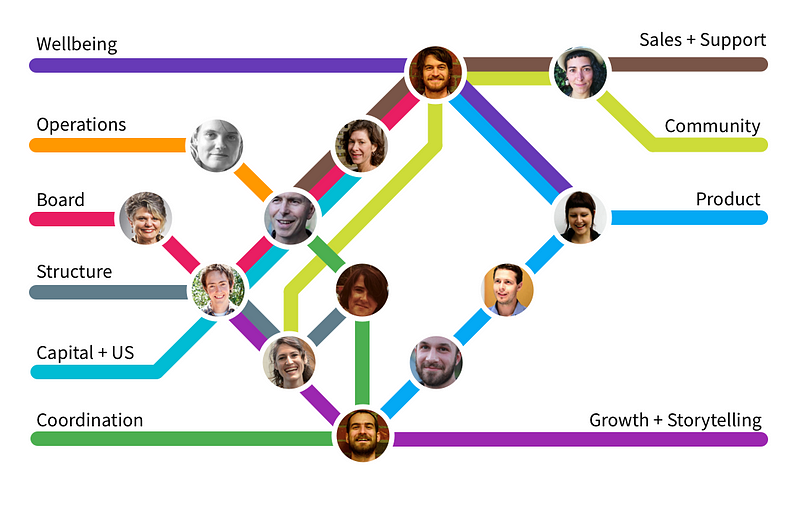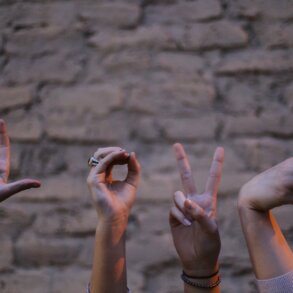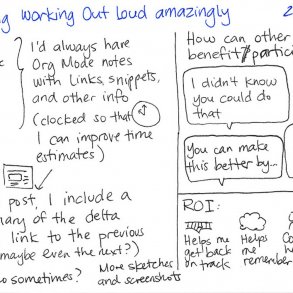By Richard D. Bartlett and originally published here.

My first impression at OuiShare Fest was a weird utopian blockchain mania: a poorly understood but massively hyped technology that will somehow fix all our social, political, and economic inequities.
As I got to know some of the people here though, I started to see through the fog of hype and find a lot of incredible people taking on tough challenges in a really pragmatic/idealistic way.
Everyone here has an awesome idea, and they want to work on it in a decentralised, leaderless, nonhierarchical, bossless way.
But the question that so many of them have in common is about bootstrapping: how do I go from this idealistic concept to a highly functioning non-hierarchical purpose-driven organisation?
They have a more-or-less clear aspiration for the 21st century organisation they want to build, but don’t have a clear idea of how to get there. There’s a vague hope that if we just put it on the blockchain, maybe that will bypass all the difficult problems of working with humans.
So people ask me for the recipe. My five years experience as a member of Enspiral (decentralised network of 300 people ‘working on stuff that matters’) and a cofounder of Loomio (software coop with 13 workers and no boss) makes me some kind of granddaddy in this scene, so people ask, what’s the recipe? What are the three easy steps to success?
As you can probably guess, there is no recipe. This challenge is so context-specific and so emergent, you have to make it up as you go along. But in the conversations I’ve had with emerging ventures like Part Up and Yellow Seed, I’m starting to notice a pattern:
1. Make your collective purpose your boss.
If you articulate your purpose, that becomes the ultimate authority in your organisation, and the criteria by which you design your structure and processes.
Ask: what impact do we want to have in the world?
2. Invest in people above all else.
The number one risk to your new venture is your relationships with each other. You can recover from a bad product or a bad business model, but if your relationships break down, your idea is most likely lost.
If you’re not willing to use coercive authority to align people’s efforts, you have to learn how to work together, which requires a great deal of emotional intelligence, humility, and willingness to change.
Ask: how do we want to relate to each other on our journey to impact?
3. Use rhythm to your advantage.
There is no map or compass when you’re navigating through emergent multidimensional space. The one thing you can count on is the steady passage of time.
For instance, in Loomio, we have tempos at different time scales:
- Daily: the whole team checks in every morning, synchronously: what did you do yesterday? what are you doing today? what support do you need? what are you doing for your wellbeing today? This generates abundant accountability, support, agility and focus, in 10 minutes per day.
- Fortnightly: we start by committing to what work we’ll deliver over the next 2 weeks. Then we finish with a retrospective where we stop to reflect on what we learned and what we’ll do differently next time. If you’re not stopping, you’re not learning.
- Quarterly: we have 13 people working with high autonomy, but we create focus by setting 3 or 4 measurable objectives that everyone is working towards.
Having these rhythms in the organisations means you can maintain your agility, without pivoting every 5 minutes. You can agree on a course for 3 months, and fine tune your direction every day. Our organisational structure is evolving every 2 weeks and everyone in the team has access to changing it. And probably the most important rhythm is our 6 monthly retreat. We go away for 3 days, crack open our chests and weave our heart stories together. This creates the affective bonds and trust that make our bossless organisation extremely productive, aligned, and mutually accountable.
That’s how Loomio works right now, but it took us years to get there. We didn’t design that blueprint first, and then start working.
In our bossless organisation, we use minimum viable structure, codesigned just in time, implemented by experiments.
Building a bridge while walking across it
You need half a dozen components in place before you can function smoothly as a mature organisation: shared vision, accountability, governance, shared identity, a decision-making protocol, and oh yeah a sustainable business model would be nice.
The challenge is that you need all of them before any of them really work. It’s like spinning plates: while you’re busy spinning up the business model, your governance starts wobbling so you quickly run over to re-balance that.
Unfortunately there is no easy answer to this impossible situation. You have to run off the cliff and build a bridge at the same time.
Organisational design is political
Most likely there’s some people in your team that are totally allergic to structure, and some that are basically obsessed with it. The two personalities can create a huge tension that sucks all the fun out of the room.

@imhaileycoop uses the ‘maturity model’ to help teams navigate this challenge. If your fully functioning mature organisation is a butterfly, think about the stages it goes through to get there: egg, larva, caterpillar, etc.
You can’t skip to the end, but you need to make sure you’re heading in the right direction. Bring this model into the room and ask the team: What are the characteristics of your butterfly? (i.e. what’s your vision for the best possible workplace?) Are we an egg or a caterpillar right now?
If you’re an egg, put your energy into egg problems, don’t worry too much about the caterpillar stage until you get there. There’s no use designing a structure for a phase you’re not in.
For example: this weekend I met the Open State crew in Berlin. They have a problem where there are too many opportunities and not enough resources to deliver them all. They need some system for prioritising work and allocating resources.
If it were my team, I’d start by getting consensus on the problem. Then I’d invite solutions, and propose some of my own ideas. Then we’d develop the ideas together until we come up with one we are reasonably comfortable with. e.g. we might invent a new role called the “unicorn” and give them some responsibilities and a process to try. Then finally, we implement the new structure, role or process, on a time-limited basis.
The time limit is critical. Some people will always be anxious about new structure. They see their beautiful dynamic leaderless swarm crystallising into a horrible static bureaucracy. But if you can agree that there is a problem, that creates the shared will to find a “good enough” solution together. Then try it for 3 months. At the end of the trial, you review and decide to continue, improve, or reject it.
So why not get started!
It’s tremendously difficult, but it’s tremendously rewarding. Doing meaningful work in a truly collaborative environment creates the deepest solidarity I’ve ever experienced. Everyday I’m growing and learning, and I’m super stoked to share my experiences, just ping me on twitter @richdecibels if you want to chat while I’m in Paris this week 🙂
p.s. check out a beautiful response to this post from Theodore Taptiklis: Getting from a Bossy to a Bossless Organisation in 3 Painful Steps :-}
Note: The Featured Image of a pink dahlia has been added above by Enlivening Edge for our magazine format.




